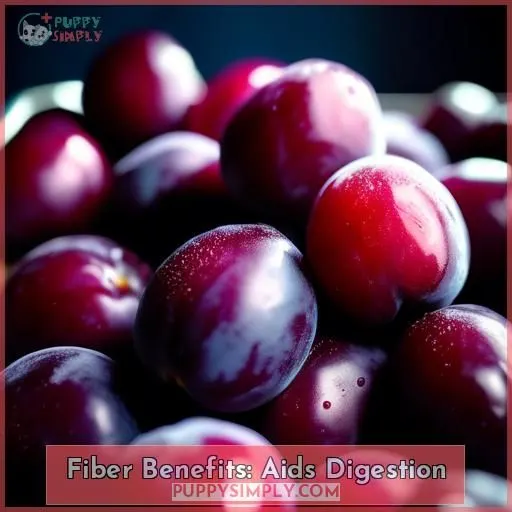This site is supported by our readers. We may earn a commission, at no cost to you, if you purchase through links.

Yes, dogs can consume plum flesh sparingly.
But you must extract the pit to avert choking and intestinal obstructions.
Plums bestow advantages such as fiber for wholesome digestion, vitamins A and C, and antioxidants.
However, their substantial sugar content presents a hazard for weight gain if excessive amounts are consumed.
Observe your pup for any negative reactions such as regurgitation or loose stools.
While plums can foster well-being, portion control is paramount.
Desire to guarantee your beloved companion savors the sweet treat securely?
Continue reading to acquire crucial guidance on incorporating plums into their diet.
Table Of Contents
Key Takeaways
- Dogs can consume plum flesh sparingly, but the pit must be removed to avoid choking and intestinal blockages.
- Plums contain fiber, vitamins A and C, and antioxidants, which can promote a dog’s well-being.
- The high sugar content in plums can lead to weight gain and other health issues if consumed in excessive quantities.
- Plum pits contain cyanide and can cause choking or intestinal blockages if ingested by dogs.
Can Dogs Eat Plum?
Yes, dogs can eat plums, but only the flesh of the fruit without the pit, stem, or leaves, as these parts contain cyanide which can be toxic to dogs. Plums are a good source of fiber, vitamins A and C, and potassium, which can benefit dogs’ digestion when fed in moderation. However, plums are high in sugar, so it’s essential to limit the amount given to your dog to prevent obesity and other health issues. Always consult with your veterinarian before introducing new foods to your dog’s diet, as their individual needs and health conditions may vary.
Plum Pits: Dangers for Dogs
Plum pits can pose a significant danger to dogs.
They can cause choking or intestinal blockages due to their small size and sharp edges.
The pit also contains cyanide, which can be toxic if the dog chews on it and releases the cyanide from the center of the pit.
If your dog ingests a plum pit, monitor them closely for any signs of illness, including vomiting, loss of appetite, weakness, diarrhea, and weight loss.
If your dog is choking or has a blockage, seek emergency medical attention.
Signs of intestinal blockage can include vomiting, diarrhea, abdominal pain, and loss of appetite.
To minimize the risk of your dog swallowing a plum pit, store plums in the refrigerator or in a closed cupboard so your pet cannot steal them off the counter.
Plum Flesh: Safe in Moderation
Dogs can consume plum flesh in moderation.
It’s essential to remove the pit and stem prior to feeding.
Plums are abundant in fiber, antioxidants, and vitamins, which can promote your dog’s well-being.
Plum pits harbor cyanide and may provoke choking or intestinal blockage if consumed.
The substantial sugar content in plums can contribute to weight gain and other health complications when fed in excessive quantities.
To safely offer plums to your dog, slice them into diminutive pieces and observe your dog for any indications of toxicity or digestive disturbances.
Seek the counsel of your veterinarian before incorporating plums into your dog’s diet.
High Sugar Content: Weight Gain Risks
If your dog is craving a sweet treat, be aware of the sugar content in plums. Plums are a good source of fiber, vitamins A and C, and potassium. However, they also contain a high amount of sugar.
Overeating plums can lead to weight gain and other health issues. To ensure your dog gets the benefits without the risks, feed them plums in small amounts. Keep an eye on your dog’s weight and adjust their diet as needed.
Fiber Benefits: Aids Digestion
While plums contain a good amount of dietary fiber that can aid in digestion for dogs, it’s crucial to remove the pit completely before feeding.
Ingesting the pit can lead to intestinal blockages or even cyanide poisoning.
Despite the fiber benefits, you should also limit your dog’s plum intake due to the high sugar content.
The high sugar content can contribute to weight gain and other health issues.
Plum Fiber Benefits
Plums are a nutritious treat for dogs, providing a range of health benefits.
One of the key benefits is their high fiber content, which aids digestion and helps prevent constipation. Fiber works like a scrub in your dog’s intestines, removing waste materials and promoting healthy bowel movements.
This fiber-rich fruit can also help reduce the risk of diarrhea and gastrointestinal infections in dogs.
Plum Pit Dangers
Plum pits: Dangers for Dogs
- Cyanide poisoning: Plum pits contain cyanide, which can cause severe symptoms such as shock, difficulty breathing, and even death within an hour if untreated.
- Choking hazard: Plum pits can pose a choking hazard, especially for smaller breeds.
- Intestinal blockage: Ingestion of plum pits can lead to intestinal blockage, which may require emergency surgery.
- Emergency treatment: If your dog ingests a plum pit, seek immediate veterinary attention to prevent cyanide poisoning and potential blockage.
To guarantee your dog’s safety, always remove the pit before feeding them plums. Keep plum trees and their foliage out of your dog’s reach, and be aware of the risks associated with plum pits.
Plum Sugar Content
Plums can be a delectable treat for your furry companion, but it’s crucial to be mindful of the sugar content. Plums contain approximately 9.9 grams of sugar per 100 grams, comparable to apples. While the sugar in plums is naturally occurring and encompasses beneficial fibers, vitamins, and minerals, it’s still imperative to feed them in moderation to prevent contributing to weight gain or obesity.
To safely provide plums to your dog, meticulously remove the pit and stem before offering small morsels as a treat or snack. Vigilantly monitor your dog for indications of toxicity or digestive difficulties following consumption. If your dog ingests a plum pit, seek emergency medical attention promptly if they exhibit signs of choking or a blockage.
When considering plums as a treat for your dog, bear in mind that they shouldn’t constitute their primary sustenance. Instead, offer them as an occasional indulgence, alongside other fruits such as bananas, which are also an excellent source of fiber and antioxidants.
Vitamins and Antioxidants: Health Boosters
Plums aren’t just a tasty treat for us, they also offer numerous health benefits for our furry friends. Here’s what you need to know about the vitamins and antioxidants in plums that can boost your dog’s health:
- Vitamin A: This vitamin is essential for maintaining healthy skin and eyesight. It also helps support the immune system and promotes cell growth.
- Vitamin C: This vitamin is a powerful antioxidant that helps protect cells from damage. It also supports the immune system and can help reduce inflammation.
- Antioxidants: Plums are rich in antioxidants, which help protect cells from damage caused by free radicals. This can help reduce the risk of chronic diseases and promote overall health.
- Fiber: Plums are a good source of fiber, which can aid digestion and promote healthy gut bacteria. This can help prevent digestive issues and support overall health.
Incorporating plums into your dog’s diet can provide these health benefits, but remember to remove the pit and stem before feeding, and offer them in moderation. Always consult with your veterinarian before making any changes to your dog’s diet.
Monitoring After Consumption
After pampering your pooch with plum perks like fiber and vitamins, keep your eyes peeled for any pesky side effects.
Just like us, dogs can have allergic reactions or a bit of digestive upset after trying new berries or fruits.
It’s a treat, not a training session, so no need to overdo it.
Offer a morsel of plum and watch for signs of trouble—nobody wants a choking hazard to spoil the party.
If your furry friend starts coughing or pawing at their mouth, it’s time to intervene.
And remember, plums pack a punch of sugar, so too much can lead to dehydration.
Stick to dog-friendly fruits in bite-sized bits to keep tails wagging.
Consulting a Veterinarian
Before offering plums to your canine companion, it’s essential to seek advice from a veterinarian.
While plums can be a beneficial snack for dogs, they may not be appropriate for all canines, particularly those with sensitive digestive systems or allergies.
A veterinarian can assist in determining the appropriate serving size for your dog considering their age, size, and overall well-being.
They can also provide guidance on how to prepare and serve plums to ensure your dog reaps the nutritional benefits without any adverse reactions.
Additionally, a veterinarian can address any dietary considerations and confirm that plums are a healthy addition to your dog’s diet.
Bear in mind that plums should be a treat, not a staple food, and shouldn’t substitute a balanced diet.
Frequently Asked Questions (FAQs)
What are the benefits of feeding plums to dogs?
Feeding your pup small portions of plum flesh provides fiber for healthy digestion, vitamins A and C for a shiny coat, and antioxidants to boost their immune system. Just be sure to remove the pit – that’s a choking hazard.
How much plum can dogs safely consume?
You’ll want to keep plum servings small – around 1-2 slices for larger dogs, or 1/2 slice for smaller pups. Too much can cause tummy troubles from the high sugar and fiber content. Moderation is key when treating your furry friend to this juicy snack!
Can dogs eat plum leaves or roots?
No, you shouldn’t let your pup munch on plum leaves or roots. Those parts of the plant contain cyanide, a deadly toxin that could seriously harm or even kill your furry friend. Stick to just the flesh of ripe plums as an occasional treat.
What should I do if my dog eats a plum pit?
As a rock hitting the windshield, a plum pit can shatter your pup’s well-being. Rush to the vet immediately – that foreign object needs professional removal before causing an intestinal blockage or worse. Your dog’s health is priority one, so don’t delay.
How can I safely feed plums to my dog?
To safely feed plums, remove the pit and stem first. Cut into bite-sized pieces, and feed only a small amount as a treat. Monitor for any digestive issues, and if concerned, check with your vet. Moderation is key when sharing this sweet, fiber-rich fruit.
Conclusion
Visualize your beloved pet relishing a luscious, succulent plum – a moment of pure delight.
However, it’s imperative to prioritize their safety when considering whether dogs can consume plums.
Moderate amounts of plum flesh provide fiber and antioxidants, but observe closely for any reactions.
Steer clear of the pit, and remain cognizant of the sugar content.
By adhering to responsible treat-giving practices, your pup can savor this delectable fruit while upholding their well-being.












